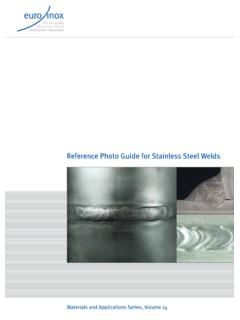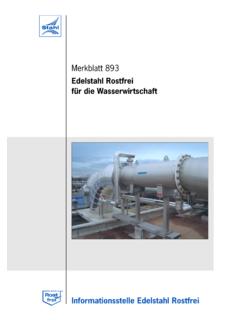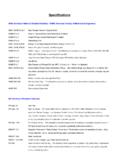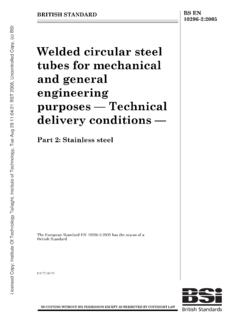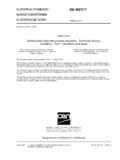Transcription of The Welding of Stainless Steels - edelstahl-rostfrei.de
1 The Welding of Stainless Steelsby Pierre-Jean CunatMaterials and Applications Series, Volume 3 THE Welding OF Stainless STEELSEuro InoxEuro Inox is the European market development associ-ation for Stainless of Euro Inox include: European Stainless steel producers National Stainless steel development associations Development associations of the alloying prime objectives of Euro Inox are to createawareness of the unique properties of Stainless steelsand to further its use in both existing applications andnew markets. To achieve these objectives, Euro Inoxorganises conferences and seminars, and issuesguidance in printed and electronic form, to enabledesigners, specifiers, manufacturers and end users tobecome more familiar with the material. Euro Inox alsosupports technical and market 978-2-87997-180-32-87997-087-3 Polish version978-2-87997-177-3 Czech version978-2-87997-178-0 Dutch version978-2-87997-179-7 Turkish versionFull Acciai Speciali & ALZ BelgiumUGINE & ALZ FranceArcelor Mittal Stainless steel Association (BSSA) Edelstahl de D veloppement de l Inox ( ) Chromium Development Association (ICDA) Molybdenum Association (IMOA) Unia Dystrybutor w Stali (PUDS) Welding OF Stainless STEELSThe Welding of Stainless SteelsSecond Edition, 2007(Materials and Applications Series, Volume 3) Euro Inox 2001, 2007 PublisherEuro InoxRegistered office: 241 route d Arlon1150 Luxembourg, Grand Duchy of LuxembourgPhone +352 261 03 050, Fax +352 261 03 051 Executive office: Diamant Building, Bd.
2 A. Reyers 801030 Brussels, BelgiumPhone +32 2 706 82 67, Fax +32 2 706 82 69E-mail: Cunat, Joinville-le-Pont, FranceAcknowledgementThe paragraphs marked (*) in the text are extracted from Working with Stainless Steels ,Paris (SIRPE) 1998 Cover PhotographESAB AB, G teborg (S)Contents1 General information on Stainless steels22 Stainless steel Welding processes 33 Weldability of Stainless steels234 Selecting shielding gases for Welding of Stainless steels245 Selecting Welding consumables for Welding of Stainless steels256 Joint preparation in arc welding267 Finishing treatments for welds288 Safe practices309 Glossary: terms and definitions32 DisclaimerEuro Inox has made every effort to ensure that theinformation presented here is technically , the reader is advised that the material contained herein is for general information purposesonly.
3 Euro Inox, its members, staff, and consultants,specifically disclaim any liability or responsibility forloss, damage, or injury, resulting from the use of theinformation contained in this noticeThis work is subject to copyright. Euro Inox reserves allrights of translation in any language, reprinting, re-useof illustrations, recitations and broadcasting. No partof this publication may be reproduced, stored in aretrieval system, or transmitted in any form or by anymeans, electronic, mechanical, photocopying, recordingor otherwise, without the prior written permission ofthe copyright owner, Euro-Inox, Luxembourg. Violationsmay be subject to legal proceeding and liable for monetary damages per infringement as well as costand legal fees and fall under prosecution act of theLuxembourg copyright law and regulations within theEuropean Welding OF Stainless STEELS21 General Information on Stainless Austenitic - Ferritic DuplexStainless Steels : Fe-Cr-Ni (Mo)-NThe microstructure of duplex stainlesssteels consists of a mixture of austeniteand ferrite.
4 They exhibit characteristics of both phases with higher strength andductility. Nitrogen is added to providestrength and also aids in weldability. Theyare magnetic and non-hardenable by heattreatment. Range of compositions: C - 21% Cr 26% - Ni 8% - (Mo ) -N Martensitic Stainless Steels : Fe-Cr-(Mo-Ni-V)These alloys can be heat treated to a widerange of useful hardness martensic structure obtained is of compositions: C - Cr 17% - (Mo - Ni 6% - V ) Austenitic Stainless Steels : Fe-Cr-Ni (Mo)These alloys are the most popular gradesof Stainless Steels because of their excel-lent formability, corrosion resistance, andweldability. All are non-magnetic in theannealed of compositions: C - 16% Cr 28% - Ni 32% - (Mo 7%) Ferritic Stainless Steels : Fe-Cr-(Mo)Ferritic Stainless Steels have a low carboncontent, with chromium (and molybdenum)as major alloying are non-hardenable by heat treatmentand are always of compositions: C - Cr 30% - (Mo )THE Welding OF Stainless STEELS32 Stainless steel Welding Arc Processes with a RefractoryMetal Gas Tungsten Arc Welding :GTAW (*)The GTAW process, also known as the TIG(Tungsten Inert Gas) or WIG (Wolfram InertGas) process, is illustrated in the above fig-ure.
5 The energy necessary for melting themetal is supplied by an electric arc struckand maintained between a tungsten ortungsten alloy electrode and the work-piece, under an inert or slightly reducingatmosphere. Stainless Steels are alwayswelded in the DCEN (Direct CurrentElectrode Negative) or DCSP (Direct CurrentStraight Polarity) mode. In these condi-tions, it is the workpiece that is struck bythe electrons, enhancing penetration, whilethe electrode, which is generally madefrom thoriated tungsten (2% ThO2), under-goes very little wear. If a filler metal isemployed, it is in the form of either barerods or coiled wire for automatic inert gas flow which protects the arczone from the ambient air, enables a verystable arc to be maintained. Depending onthe base material, shielding gases consistmainly of mixtures of argon (Ar), helium(He) and hydrogen (H2) (see section 4 Selection of shielding gases for weldingstainless steel ).
6 70 90 20 Direction of travelShieldinggas inletCopper support+Backing gasFiller metalArcShielding gasWeldingpower supplyTorchCeramic nozzleRefractory metal electrodePrinciple of manual gas tungsten-arc weldingWeldingpowersupplyShielding gasShielding gasWaterWaterPlasma-forming gasPlasma-forming gasCathode (thoria-ted W)Direction of travelWeld poolPlasma streamSolidified weldWorkpieceH. Welding OF Stainless STEELS4 an excellent metallurgical quality, with aprecise control of penetration and weldshape in all positions; sound and pore-free welds very low electrode wear easy apprenticeshipThe common workpiece thickness range is mm to / main advantages of this process whenused on Stainless Steels can be sum-marised as follows: a concentrated heat source, leading toa narrow fusion zone; a very stable arc and calm Welding poolof small size. Spatter is absent andbecause no flux is required in theprocess, oxidation residues are elimin-ated so that any final cleaning opera-tion is very much simplified; Plasma Arc Welding : PAW (*)Plasma Welding is similar to Gas TungstenArc Welding (GTAW).
7 The significant differ-ence is that the arc plasmais constricted bya nozzle to produce a high-energy plasmastream in which temperatures between 10 000 and 20 000 C are attained. Welding processes generally employ a transferred arc configuration, where theconstricted arc is formed between the elec-trode and the workpiece, whereas otherapplications more often use a non-trans-ferred constricted arc. Principle of keyholeplasma weldingTHE Welding OF Stainless STEELS5 Since the plasma jet is extremely narrow, it cannot provide adequate protection forthe weld pool, so that it is necessary toadd a larger diameter annular stream ofshielding gases used both for this purpose and for forming the plasma are similar tothose employed in GTAW, namely pureargon (Ar), Ar hydrogen (H2) up to 20%, Ar-helium (He) H2. The hydrogen-contain-ing mixtures are recommended for weldingaustenitic Stainless Steels , but like in thecase of GTAW, are be to proscribed for fer-ritic, martensitic and duplex grades.
8 For thelatter materials, it is recommended to addnitrogen to maintain the appropriate pro-portions of austenite and ferrite in theweld (see section 4 Selecting shieldinggases for Welding Stainless Steels ). In manual plasma Welding , where the torchis hand-held, the so-called micro-plasma and mini-plasma processes are employedfor currents between and 15 amperesand the non-emergent jet technique forcurrents between about 15 and 100amperes. In automatic Welding , where the torch ismounted on a carriage, the so-called key-hole process is employed. By increasingthe Welding current (above 100 amperes)and plasma gas flow, a very powerful plasma beam is created which can achievefull penetration in the workpiece. Duringwelding, the hole progressively cuts throughthe metal with the weld pool flowing inbehind to form the weld.
9 The major advantage of the PAW processover GTAW is the remarkable stability ofthe arc leading to: a rigid arc which enables better controlof power input; greater tolerance to variations in nozzle- workpiece distance, without significant modification to the weldmorphology; a narrow heat-affected zone (HAZ) andgenerally faster Welding speeds; greater tolerance to faulty preparation,particularly in the case of keyhole common workpiece thickness range is: mm to mm for micro-plasma andmini-plasma processes mm to mm for the non-emergentjet technique mm to mm for the keyholeprocess (in a single pass).THE Welding OF Stainless Processes with a Gas Metal Arc Welding : GMAW (*)In the GMAW process, also known as toMIG (Metal Inert Gas) process, the weldingheat is produced by an arc struck betweena continuously fed metal wire electrodeand the to the GTAW and PAW processes,the electrode is consumable, an arc beingstruck between the fusible filler wire andthe workpiece under a shielding essential characteristics of this processare: the use of very high current densities inthe electrode wire (>90A/mm2), about 10 times higher than in the coveredelectrode (SMAW) process; rapid melting of the electrode wire(melting rate of about 8 m/min) due tothe high temperature of the arc, makingit necessary to use an automatic wirefeed system, supplied by 12 kg.
10 Spools; Stainless Steels are always welded inthe DCEP (Direct Current ElectrodePositive) or DCRP (Direct Current ReversePolarity) mode, the positive pole of thegenerator being connected to the elec-trode; the Welding torch is generally held manually (so-called semi-automatic process), but for high Welding powers it is fixed to a carriage ( automatic process).WeldingpowersupplySpool of filler wireShielding gas regulatorShielding gas supplyDirection oftravelWorkpieceNozzleContact tubeTorch220/380 VFeed rollsControl consoleCommand cableCurrent conductorMetallic sheathSolid electrode wireShielding gas inletElectrode feed unit including:Wire feeder: wire drive motorand feed rollsControl console: Gas electrovalve,Command relays and electronic controllersPrinciple of gas metalarc weldingTHE Welding OF Stainless STEELS7 The mechanism of metal transfer in the arcis an important process parameter, threeprinciple modes being distinguished.
